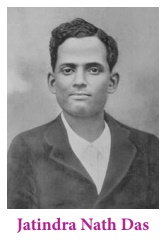Bhagat Singh
Bhagat Singh’s Background
Bhagat Singh represented a distinct strand of nationalism. His radical strand complemented, in a unique way, to the overall ideals of the freedom movement.
“I began to study. My previous faith and convictions underwent a remarkable modification. The romance of the violent methods alone which was so prominent among our predecessors was replaced by serious ideas. No more mysticism, no more blind faith. Realism became our cult. Use of force justifiable when resorted to as a matter of terrible necessity: non-violence as a policy indispensable for all mass movements. So much about methods. The most important thing was the clear conception of the ideal for which we were to fight….. from Bhagat Singh’s “Why I am an Atheist”.
Bhagat Singh was born to Kishan Singh (father) and Vidyavati Kaur (mother) on 28 September 1907 in Jaranwala, Lyallpur district, Punjab, now a part of Pakistan. His father was a liberal and his family was a family of freedom fighters. The Jallianwala Bagh massacre happened when Bhagat Singh was 14 years. Early in his youth, he was associated with the Naujawan Bharat Sabha and the Hindustan Republican Association. The latter organisation was founded by Sachin Sanyal and Jogesh Chatterji. It was reorganised subsequently in September 1928 as the Hindustan Socialist Republican Association (H.S.R.A) by Bhagat Singh and his comrades. Socialist ideals and the October Revolution in Russia of 1917 were large influences on these revolutionaries. Bhagat Singh was one of the leaders of the H.S.R.A along with Chandrashekhar Azad, Shivaram Rajguru and Sukhdev Thapar.
Bhagat Singh’s Bomb Throwing
The image that comes to our mind at the very mention of Bhagat Singh’s name is that of the bomb he threw in the Central Legislative Assembly on April 8, 1929. The bombs did not kill anybody. It was intended as a demonstrative action, an act of protest against the draconian laws of the British. They chose the day on which the Trade Disputes Bill, an anti-labour legislation was introduced in the assembly.
Lahore Conspiracy Case
Bhagat Singh along with Rajguru, Sukhdev, Jatindra Nath Das and 21 others were arrested and tried for the murder of Saunders (the case was known as the Second Lahore Conspiracy Case). Jatindra Nath Das died in the jail after 64 days of hunger strike against the discriminatory practices and poor conditions in jail. The verdict in the bomb throwing case had been suspended until the trial of Lahore Conspiracy trials was over. It was in this case that Bhagat Singh, Rajguru and Sukhdev were sentenced to death on 7 October 1930.

A letter from them to the Governor of Punjab shows their courage and their optimism over the future of India even while facing death for the cause of freedom of their country. It says, ‘the days of capitalism and imperialism are numbered. The war neither began with us nor is going to end with our lives… According to the verdict of your court we had waged a war and we are therefore war prisoners. And we claim to be treated as such i.e., we claim to be shot dead instead of being hanged.”
Some narratives describe Bhagat Singh and his fellow patriots as terrorists. This is a misconception. The legendary Bhagat Singh clarified how his group is different from the terrorists. He said, during his trial, that revolution is not just the cult of bomb and pistol…Revolution is the inalienable right of mankind. Freedom is the imperishable birth-right of all. The labourer is the real sustainer of society.. To the altar of this revolution we have brought our youth as incense, for no sacrifice is too great for so magnificent a cause.’ Symbolically, they also shouted Inquilab Zindabad after this defence statement of his inthe court.
Bhagat Singh, Rajguru and Sukhdev were hanged early in the morning of March 23, 1931 in the Lahore Jail. They faced the gallows with courage, shouting Inquilab Zindabad and Down with British Imperialism until their last breath. The history of freedom struggle is incomplete without the revolutionary strand of nationalism and the ultimate sacrifice of these revolutionaries. One more name in the list of such fighters is Kalpana Dutt.
The H.S.R.A was a renewed chapter of the Hindustan Republican Association. Its aim was the overthrow of the capitalist and imperialist government and establish a socialist society through a revolution. The H.S.R.A involved a number of actions such as the murder of Saunders in Lahore. In that, Saunders was mistaken for the Superintendent of Police, Lahore, James A. Scott who was responsible for seriously assaulting Lajpat Rai, in December 1928, and Rai’s subsequent death. They also made an attempt to blow up the train in which Lord Irwin (Governor General and Viceroy of India, 1926-1931) was travelling, in December 1929, and a large number of such actions in Punjab and UP in 1930.














